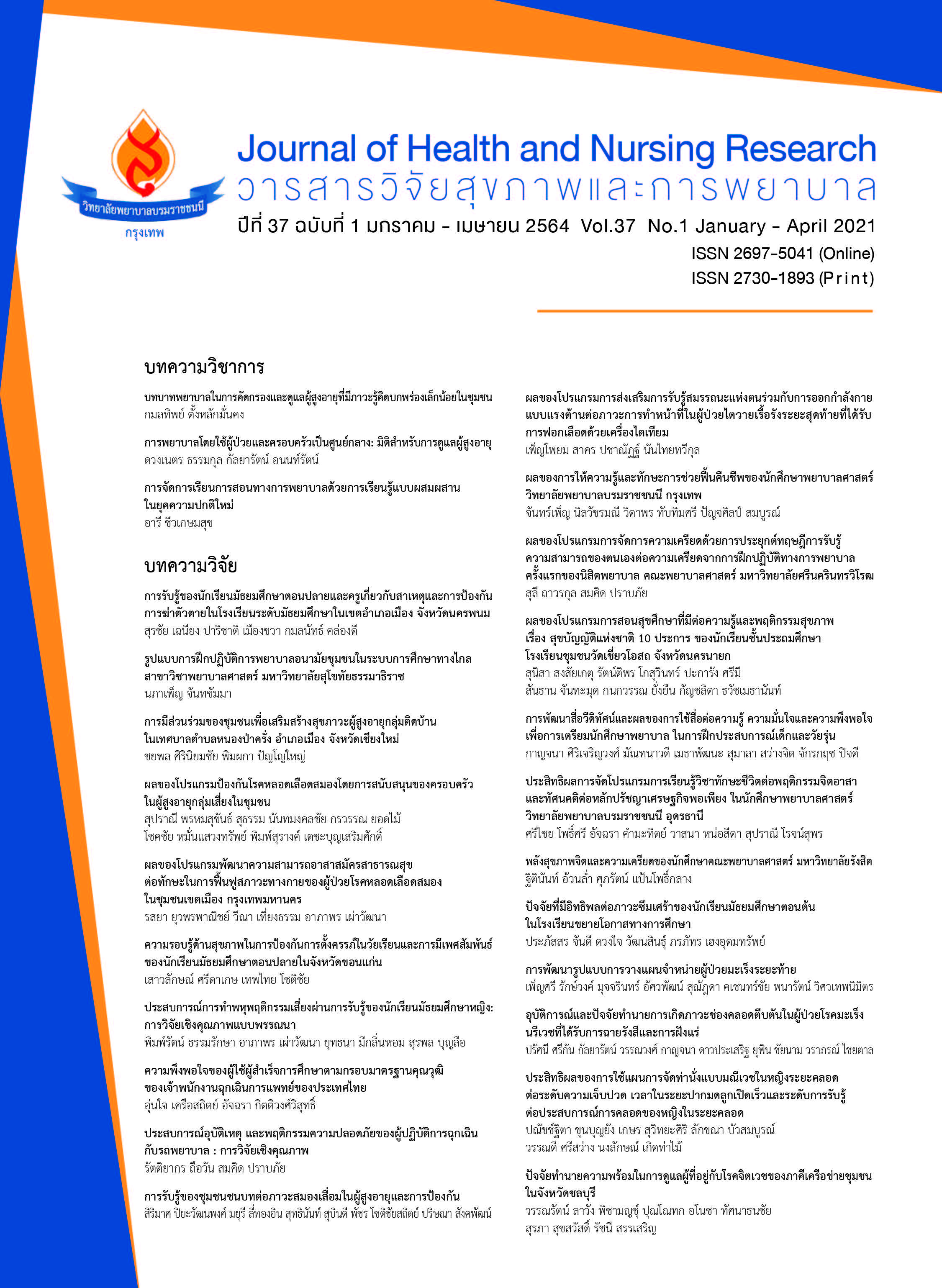อุบัติการณ์และปัจจัยทำนายการเกิดภาวะช่องคลอดตีบตันในผู้ป่วยโรคมะเร็งนรีเวชที่ได้รับการฉายรังสีและการฝังแร่
คำสำคัญ:
ภาวะช่องคลอดตีบตัน, การฉายรังสี, การฝังแร่, มะเร็งทางนรีเวชบทคัดย่อ
บทนำ: ภาวะช่องคลอดตีบตันเป็นผลกระทบที่พบได้บ่อยในผู้ป่วยโรคมะเร็งทางนรีเวชที่ได้รับการฉายรังสีหรือการฝังแร่ วัตถุประสงค์: เพื่อศึกษาอุบัติการณ์และปัจจัยทำนายการเกิดภาวะช่องคลอดตีบตันในผู้ป่วยโรคมะเร็งทางนรีเวช ระเบียบวิธีวิจัย: เป็นการวิจัยแบบย้อนหลัง โดยการศึกษารายงานเวชระเบียนของผู้ป่วยโรคมะเร็งทางนรีเวชได้รับการรักษาฉายรังสีและการฝังแร่บริเวณอุ้งเชิงกรานในโรงพยาบาลมะเร็งลำปาง ตั้งแต่วันที่ 1 เดือนมกราคม พ.ศ. 2556 – ธันวาคม พ.ศ. 2560 ที่มีประวัติของการติดตามการรักษา (follow-up) หลังการรักษา ครบเป็นเวลาอย่างน้อย 3 เดือน จำนวน 719 ฉบับ ซึ่งปัจจัยที่ศึกษาประกอบด้วย อายุของผู้ป่วย สถานภาพสมรส โรคประจำตัว ชนิดของโรคมะเร็ง ชนิดของโรคมะเร็ง ปริมาณของรังสีทั้งหมดจากการฉายรังสี ปริมาณรังสีที่ฉายในแต่ละครั้ง จำนวนครั้งของการฉายรังสี ปริมาณแร่ที่ฝังทั้งหมด ปริมาณแร่ที่ฝังในแต่ละครั้ง จำนวนครั้งของการฝังแร่ และการรักษาร่วมกับเคมีบำบัด ผลการวิจัย: พบว่ากลุ่มตัวอย่างร้อยละ 60 มีอายุระหว่าง 41 - 60 ปี (Range = 23 - 90 ปี, Mean = 56.11 ปี, SD. = 11.60 ปี) ร้อยละ 94.20 มีสถานภาพสมรส และป่วยเป็นโรคมะเร็งปากมดลูก 86.40 ภาวะช่องคลอดตีบตันพบได้ร้อยละ 23 มีความรุนแรงระดับสอง (Grade 2) ซึ่งมักเกิดภาวะช่องคลอดตีบตันในช่วงระยะเวลา 1 - 12 เดือนหลังสิ้นสุดการรักษา (ร้อยละ 61.03) ปริมาณรังสีทั้งหมดจากการฉายรังสี (Beta = .157) และอายุ (Beta = .123) เป็นปัจจัยที่ทำนายการเกิดภาวะช่องคลอดตีบตันอย่างมีนัยสำคัญทางสถิติ สรุปผล: ปริมาณรังสีและอายุของผู้ป่วยเป็นปัจจัยที่สำคัญที่ทำให้เกิดภาวะช่องคลอดตีบตัน ข้อเสนอแนะ: ผู้ป่วยมะเร็งทางนรีเวชที่ได้รับปริมาณรังสีที่สูงและมีอายุมากกว่า 50 ปี ควรได้รับการเฝ้าระวังการเกิดภาวะช่องคลอดตีบตันอย่างสม่ำเสมอและควรได้รับคำแนะนำในการใช้เครื่องถ่างขยายช่องคลอด
Downloads
เอกสารอ้างอิง
Hofsjö A, Bohm-Starke N, Blomgren B, Jahren H, Steineck G, Bergmark K. Radiotherapy-induced vaginal fibrosis in cervical cancer survivors. Acta Oncologica. 2017;56(5):661-6.
Morris L, Do V, Chard J, Brand AH. Radiation-induced vaginal stenosis: Current perspectives. International Journal of Women's Health and Reproduction 2017;9:273-9.
Pfaendler KS, Wenzel L, Mechanic MB, Penner KR. Cervical cancer survivorship: Long-term quality of life and social support. Clinical Therapeutics 2015;37(1):39-48.
Brand AH, Bull CA, Cakir B. Vaginal stenosis in patients treated with radiotherapy for carcinoma of the cervix. International Journal of Gynecologic Cancer. 2006;16(1):288-93.
Bansal N, Soni A, Khurana A, Verma Y, Kaur P, Chauhan AK. Vaginal dilator therapy to prevent stenosis from radiotherapy: A systematic review. Asian Journal of Oncology 2016;02(S 01):111.
Khor T, Tuan J, Hee S, Tham I. Radical radiotherapy with high-dose-rate brachytherapy for uterine cervix cancer long-term results. Australasian Radiology. 2007;51(6):570-7.
Kirchheiner K, Nout RA, Lindegaard JC, Haie-Meder C, Mahantshetty U, Segedin B, et al. Dose-effect relationship and risk factors for vaginal stenosis after definitive radio(chemo)therapy with image-guided brachytherapy for locally advanced cervical cancer in the EMBRACE study. Radiotherapy and Oncology 2016;118(1):160-6.
Tyree WC, Cardenes H, Randall M, Papiez L. High-dose-rate brachytherapy for vaginal cancer: Learning from treatment complications. International Journal of Gynecological Cancer 2002;12(1):27-31.
Mirabeau-Beale K, Hong TS, Niemierko A, Ancukiewicz M, Blaszkowsky LS, Crowley EM, et al.Clinical and treatment factors associated with vaginal stenosis after definitive chemoradiation for anal canal cancer. Practical Radiation Oncology 2015;5(3):30.
Martins J, Vaz AF, Grion RC, Esteves SCB, Costa-Paiva L, Baccaro LF. Factors associated with changes in vaginal length and diameter during pelvic radiotherapy for cervical cancer. Archives of gynecology and obstetrics. 2017. Epub 2017/10/05.
Johnson N, Miles TP, Cornes P. Dilating the vagina to prevent damage from radiotherapy:
Systematic review of the literature. British Journal of Obstetrics and Gynaecology (BJOG).
;117(5):522-31.
Correa CS, Leite IC, Andrade AP, de Souza Sergio Ferreira A, Carvalho SM, Guerra MR. Sexual function of women surviving cervical cancer. Archives of gynecology and obstetrics. 2016;293(5):1053-63. Epub 2015/09/04.
Law E, Kelvin JF, Thom B, Riedel E, Tom A, Carter J, et al. Prospective study of vaginal dilator use adherence and efficacy following radiotherapy. Radiotherapy and oncology : journal of the European Society for Therapeutic Radiology and Oncology 2015;116(1):149-55. Epub 2015/07/15.
McLeroy KR, Bibeau D, Steckler A, Glanz K. An ecological perspective on health promotion programs. Health Education Quarterly 1988;15(4):351-77.
Güth U, Ella WA, Olaitan A, Hadwin RJ, Arora R, McCormack M. Total vaginal necrosis: A representative example of underreporting severe late toxic reaction after concomitant chemoradiation for cervical cancer. International Journal of Gynecological Cancer. 2010;20(1):54-60.
Yoshida K, Yamazaki H, Nakamura S, Masui K, Kotsuma T, Akiyama H, et al. Role of vaginal pallor reaction in predicting late vaginal stenosis after high-dose-rate brachytherapy in treatment-naive patients with cervical cancer. J Gynecol Oncol 2015;26(3):179-84.
Bahng AY, Dagan A, Bruner DW, Lin LL. Determination of prognostic factors for vaginal mucosal toxicity associated with intravaginal high-dose rate brachytherapy in patients with endometrial cancer. International Journal of Radiation Oncology, Biology, Physics. 2012;82(2):667-73.
Stinesen Kollberg K, Waldenström AC, Bergmark K, Dunberger G, Rossander A, Wilderäng U, et al. Reduced vaginal elasticity, reduced lubrication, and deep and superficial dyspareunia in irradiated gynecological cancer survivors. Acta Oncologica 2015;54(5):772-9.
Susko M, Craciunescu O, Meltsner S, Yang Y, Steffey B, Cai J, et al. Vaginal dose is associated with toxicity in image guided tandem ring or ovoid-based brachytherapy. International Journal of Radiation Oncology, Biology, Physics 2016;94(5):1099-105.
Park HS, Ratner ES, Lucarelli L, Polizzi S, Higgins SA, Damast S. Predictors of vaginal stenosis after intravaginal high-dose-rate brachytherapy for endometrial carcinoma. Brachytherapy 2015;14(4):464-70.
Singh R, Chopra S, Engineer R, Paul S, Kannan S, Mohanty S, et al. Dose-volume correlation of cumulative vaginal doses and late toxicity after adjuvant external radiation and brachytherapy for cervical cancer. Brachytherapy. 2017;16(4):855-61.
Son CH, Law E, Oh JH, Apte AP, Yang TJ, Riedel E, et al. Dosimetric predictors of radiation-induced vaginal stenosis after pelvic radiation therapy for rectal and anal cancer. International Journal of Radiation Oncology, Biology, Physics. 2015;92(3):548-54.
Laliscia. C., Delishaj D, Fabrini MG, Gonnelli A, Morganti R, Perrone F, et al. Acute and late vaginal toxicity after adjuvant high-dose-rate vaginal brachytherapy in patients with intermediate risk endometrial cancer: Is local therapy with hyaluronic acid of clinical benefit? Journal of Contemperary Brachytherapy 2016;8(6):512-7.
Martins J, Vaz AF, Grion RC, Esteves SCB, Costa-Paiva L, Baccaro LF. Factors associated with changes in vaginal length and diameter during pelvic radiotherapy for cervical cancer. Archives of Gynecology and Obstetrics 2017;296(6):1125-33.
Sorbe B, Andris S, Leif K. Intravaginal high-dose-rate brachytherapy for stage I endometrial cancer: a randomized study of two dose-per-fraction levels. International Journal of Radiation Oncology, Biology, Physics. 2005;62(5):1385-90.
Moroney MR, Flink D, Sheeder J, Blake EA, Carrubba AR, Fisher CM, et al. Radiation therapy is not an independent risk factor for decreased sexual function in women with gynecologic cancers. Reports of Practical Oncology and Radiotherapy 2018;23(5):331-6.
Gondi V, Bentzen SM, Sklenar KL, Dunn EF, Petereit DG, Tannehill SP, et al. Severe late toxicities following concomitant chemoradiotherapy compared to radiotherapy alone in cervical cancer: an inter-era analysis. International Journal of Radiation Oncology, Biology, Physics 2012;84(4):973-82.
ดาวน์โหลด
เผยแพร่แล้ว
รูปแบบการอ้างอิง
ฉบับ
ประเภทบทความ
สัญญาอนุญาต
บทความที่ได้รับการตีพิมพ์ เป็นลิขสิทธิ์ของวารสารวิจัยสุขภาพและการพยาบาล (วิทยาลัยพยาบาลบรมราชชนนี กรุงเทพ) ไม่สามารถนำไปตีพิมพ์ซ้ำในวารสารฉบับอื่น


















